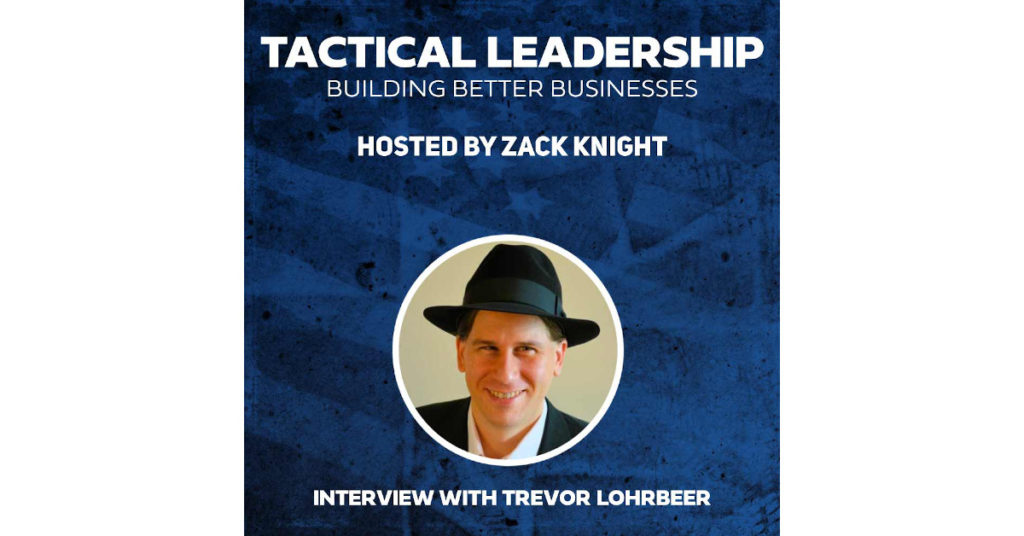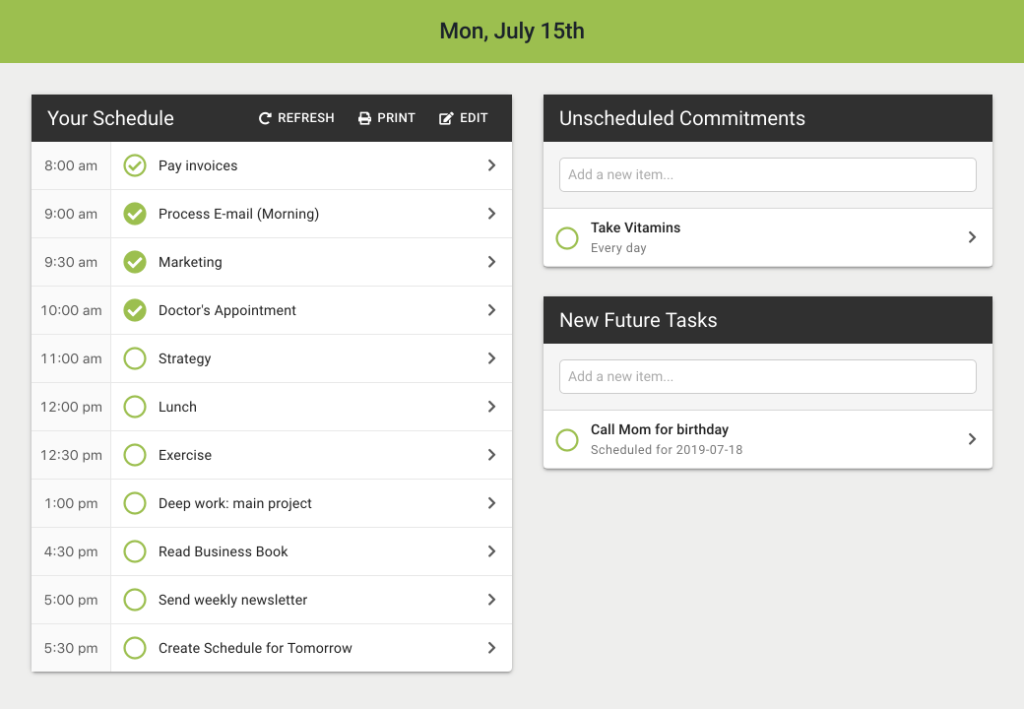I was recently interviewed by Zack Knight on the Tactical Leadership: Building Better Businesses podcast about decision patterns, load-balancing your priorities using a daily schedule and clarifying the vision of your future. Some of the topics we covered include:
- What a 100-year goal is, and what it means
- Why it’s important to clarify your goals
- How Lean Decisions can be used as a common language for decision-makers & their stakeholders
- How creating a daily schedule can help you load-balance your priorities and “solve” the Eisenhower matrix
Listen to the episode on Apple Podcasts or on the web site, or read the transcript below. To hear more episodes, subscribe to the Tactical Leadership podcast.
Zak: Welcome to another episode of the Tactical Leadership podcast, where we focus on building better businesses. I believe in order to be the best leader that you can be, you must be willing to be the first follower and have a servant mentality when you’re in a leadership position. If you want to figure out how to be the best leader you possibly can be, be sure to stay tuned and hear from industry experts about how they were able to create winning cultures in their own businesses. Hey guys, welcome back to another episode of tactical leadership.
Today, I am interviewing Trevor Lohrbeer and we’re going to be discussing how he helps leaders optimize their day in, lean out their decision making process. But before we begin, I want to remind you that this show is brought to you by Knight Protection Services. You’re a leader in a small to midsize business that does 5-10 million a year in revenue. You want to improve retention costs, which actually ended up being twice an employee salary, all through creating a safer workplace and saving up to 25% of insurance costs. Be sure to visit knightprotectionllc.com.
Trevor, welcome to the show, my friend.
Trevor: Hey, it’s great to be here.
Zack: So I want to give a little bit of a background, but let you delve further into it. You have two phenomenal projects you’re working on right now that I think will be amazing for our audience to kind of optimize their day if you will. And that kind of is a catch phrase off what you’re working on with Day Optimizer– that’s your big project. And then you also have a little bit of a side project it’s called, Lean Decisions, that you help individuals lean out that decision making process, and how to make quick actionable decisions. Before we get too far into that, tell us a little bit about your background and how you got to this point in your life and working on those projects.
Trevor: Yup. So I’ve always been a person who kind of followed my own beat, you know, and that has helped me in that has hindered me. So, it makes it hard to kind of work for someone else because I really like to be in control of my own time and creativity. I don’t like a boss kind of handing me a vision and telling me how to implement it. So that has kind of biased me toward being an entrepreneur.
At the same time, over the years I’ve discovered my superpower, is that I’m really good at taking a blank slate and creating a framework or mental model to help people think and reason about the world and to solve problems. So throughout my whole career, I’ve basically developed products and concepts that introduce new ideas into the world and help people solve existing problems in new ways.
So, you know, years ago I did a startup, my very first startup was an add-on for homepages, and then I moved into the social media space. I did a thing for Linked, basically it was LinkedIn, but we ran out of money before LinkedIn got founded. And then, my last business was a data visualization business where we help people like large enterprises, make portfolio based decisions, and came up with a lot of concepts on how to visualize large portfolios, and how all the different pieces fit together.
So throughout this whole thing, I’m coming up with new concepts and how to do it. But yeah, that’s sort of like what has brought me to where I am today.
Zack: I absolutely love it, and as I mentioned, right before we hit record, some of the things I talk about with business leaders throughout, is how difficult it is to lead oneself, but how easy it is to lead others and to lead teams and even coming from my background in law enforcement and military and now business, I always find it easier to keep others accountable and one keeping myself accountable for certain things. It’s just always takes a different level of discipline, right?
And I feel like you’ve really helped that with the products you’re currently working on, especially, especially during this lock-down time, when these more corporate individuals don’t have the entrepreneurial mindset and might not have that personal discipline. So let’s first and foremost, dive into Lean Decisions, tell us that process and how you help people lean out decision making processes.
Trevor: So the core of Lean Decisions is it’s a language to help people think about the types of decisions they’re making and how to make them more effectively. So, oftentimes when people think about decisions, they’re like, oh, there’s tons of decisions, we just make them however, but you can actually start categorizing decisions into certain sort of patterns.
So one of the common ones people often think about is the Go/No-Go decision, right? That’s a common terminology. Okay. Well, that’s where I’m kind of like walking along, down this path, and then someone gives me this opportunity. Should I do the opportunity or not? Right?
And there’s lots of different things we can consider within that sort of decision making pattern. You know, maybe I want to not make the decision right now, I want to defer a little bit longer down the road. Maybe the decision might go away but I’m going to buy an option to take the decision, et cetera.
Likewise, a similar type of decision that you think might be the same is the Continued/Canceled decision. In this case, I’m already doing it, and now I need to decide, do I cancel this project or not? Feels like almost the same type of decision, but they’re very different decisions. In one case I’ve got a bunch of sunk costs, I need to evaluate, I need to understand the consequences.
Now, both of them have opportunity costs and one case it’s the opportunity cost, if I say yes to this, I’m going to lose out on other things. On the Continue/Cancel, I’m freeing up resources for a new opportunity. So the way you evaluate those decisions are different. So I’d like to teach people to think in terms of patterns and in terms of these different types of decisions. And then what they’ll start doing is, they’ll start seeing the pattern repeat, and then they can use the learning from one pattern for one decision, and bring that over to a completely, what looks like an unrelated decision, but it’s actually the same type of decision. So that’s the core of Lean Decisions.
Zack: That’s really interesting, and I think a lot of times pattern recognition is something that’s really difficult for people to see because we lack the level of objectivity about what’s actually being laid out in front of us, right? So are you focusing on, or is Lean Decisions focused on the business leader, the entrepreneur, what level of individual are you working with to help them lean these decisions?
Trevor: So it’s more focused on leaders or people who are making the decisions. It can also be focused on people who are analyzing and advising those leaders, but it is also meant to be a, a language for all the stakeholders in the decision, to talk about it amongst themselves.
So, one of the examples I give is I’ve got, to go with a more unusual name, there’s a Conveyor Belt Decision, and if you imagine a conveyor belt where you’re in a factory and the belt is just bringing stuff down the line, and you have some stuff that just came out of the manufacturing plant so it just came through the door, it’s down the line, you can see it a little bit, but you don’t have much information about it. Then there’s something that’s much closer. You have some information, you got the stuff that’s sitting right in front of you, so that’s where he had the most information. And then they kind of fall off the line, ’cause that’s what the conveyor belt does, so they disappear.
Well, this type of decision pattern happens all over in business and our personal lives, where we have options appearing, we have varying information about that, and if we don’t act, they disappear. So if I’m going to hire someone, I’m going to sell a business, I’m going to buy a house. These are all places where they’re market driven, where the opportunity doesn’t last forever. I can’t take all the time in the world to decide whether to jump on the opportunity and I don’t have equal information. So how do I make the decision?
Well, there’s lots of techniques you can use to make that decision. Now, if all the stakeholders in there, now know this is a Conveyor Belt Decision, they can start talking about that amongst themselves. If we’re just talking about, hey, should we buy this business? A business just came on the market to the buyer. Well, you might just go off and randomly do it, but if someone points out, wait a second, this is a Conveyor Belt Decision, now they can talk at a whole other level about that decision. Does that make sense?
Zack: Absolutely, it does, and I think that from the leadership perspective, if somebody’s leading a team, I love the way you’ve kind of tied all that together where, it almost seems like a leader of a business, a CEO, can take this decision making process, implement it into part of the culture of decision making with like the C Suite and the Executive VPs, and it’s something that can really be scaled from that level all the way down to just a solopreneur working throughout the day. Is that a good grasp on that, where anybody could really implement this?
Trevor: Yeah, absolutely. Anyone anyone can really implement it. The other thing it really helps to do too, is for leaders in different industries to talk to one another, because a lot of times we don’t think about the fact that we’re making the same decisions.
So take portfolio type decisions, right? There’s allocation and selection decisions and things like that. Well, portfolio decisions happen in every single business, but there’s one industry that has really mastered those, and that’s the finance industry, because when I say portfolio, you often think stock portfolio, but what if I take the same techniques from a stock portfolio and apply those to projects?
Well, now we talk about project portfolio management today, but we can talk about that in a whole bunch of things. We can talk about that from the employees we hire, resource portfolio management, and looking at the distribution of skills and how do we build out the portfolio of our employees. Once we start thinking in terms of a portfolio decision, now we can talk to leaders in other industries, learn new techniques, new strategies, for solving those types of decisions.
Zack: I think that’s fantastic and great advice.
And moving into more of the Day Optimizer application that you’re working on, it really kind of integrates that same piece of, it’s designed for your patterns as well, whether, and I’ll let you dive more into these, but whether you’re a time optimist, ambitious procrastinator, which I think is very common among entrepreneurs, but also even right now where people might not have that inner level of discipline to accomplish tasks in their own time frame. But you also kind of notate a ball juggler where you have several things up in the air and you don’t know necessarily how to iron out your proficiencies.
How does the Day Optimizer kind of help that process where it’s almost leaning these decisions as well and helping you to prioritize your day?
Trevor: Yeah, so I think a lot of people struggle with how to balance multiple competing priorities. And so for the person who is just, you know, the technician, who’s just doing one thing all day long, that’s relatively easy. But with someone who’s had multiple projects all at once and they need to prioritize among them. They also need to make sure that they’re doing their foundational habits to keep up their energy and to keep up their focus. They need to make sure they’re doing their exercises and all that, as well as fitting in all around their meetings.
It’s really important to kind of look at your portfolio of what you’re doing and slotting things into your day and making sure that you load balance, that you balance everything across everything, so it makes sure everything’s moving forward. So one of the things that a schedule does, and that’s what Day Optimizer does–it helps you create a schedule.
It enhances that in several ways than a normal schedule would, but the core schedule lets you see everything that you’re doing in your day, block it out, and you can allocate time across your different priorities, and you can say, okay, well this is more important, so I’m going to allocate more time to it. But this is also important. So it allows you to kind of solve that Eisenhower matrix, right? The idea that we have the urgent, important things, the non-urgent important things, etcetera, it makes sure that you’re not just dealing with the urgent. You’re also dealing with the important to keep moving things forward.
Zack: So what I really like about this is that you’re not just providing a theory behind why people have struggled with this self-discipline and leading themselves. You’re actually providing solutions to lean out the decisions, optimize their day and actually prioritize and accomplish tasks. But that theory aspect of it, what do you think it is that makes it so difficult to lead oneself?
Trevor: I think just biologically, like our bodies want to conserve energy. So it’s very, we are prone to wanting not to act, right? So it’s very easy to get into the habit and it takes practice. It’s like working a muscle to get up that muscle, to act. It’s very easy to tell someone else what to do. It’s much harder to do it yourself, you know?
And so yeah, I think, I think it’s just a biological thing that like when we, as you know, early humans on the Savannah and we’re running to chase an animal, our strategy is, well, we want to conserve energy. We don’t know when we’re going to eat next. We’re not going to, so we just have this predilection to not do anything, you know, and only do anything when it’s urgent. When I see it, when I finally see the animal, okay, now let’s run and get it.
That maintenance stuff, that ability to like keep moving forward regardless, that just requires pushing yourself, and getting the right systems. No system works well for everyone. So it’s figuring out what system works well for you, and aligns well with the way your brain organizes information, the way you like to think about things. But I’m finding the systems that help support that are critical.
Zack: Absolutely love that. And it sounds like this is such a great way to integrate. And I love that a lot of times I just talk about that theory and we don’t necessarily have somebody on the show that brings the solution to the forefront like this. Do you utilize these two things to start the day? Or do you have like a morning routine that kind of gets you going in the morning and gets you optimized before work, that helps you optimize the rest of it with these tools?
Trevor: Yeah. So that’s a great question. So I think different again, this goes back to different people have different, um, ways of approaching the world in different, just natural predilections.
So, I am not one of the people who can do a morning routine. I’m actually a night owl, so that makes it harder to do a morning routine. And for years I struggled with that because the common entrepreneur advice is learn to be an early bird and all that until I found out that there’s actually many successful entrepreneurs who are night owls and that no like, you know, while it is great advice to wake up and have a standard morning routine that you go through and you develop habits around, that is great advice. It doesn’t work for everyone. And so if it’s not working for you, don’t feel bad. Um, instead figure out what works for you. And what works for me, is to wake up in the morning and plan my day. And so I wake up and I then say, okay, what does everything I need to do? When I go through the 3-step process that Day Optimizer provides to actually schedule and build my day.
Now we have other customers who build their night, the night before, again, that doesn’t work for me. Like I’m not going to sit down at the end of my day and go, okay, let me plan tomorrow. Every once in a while I do that when I really, you know, when I need to do an early day and I really need to hit it hard in the morning. But again, it takes me a couple hours in the morning to get going, my brain to get going. So, it’s better for me to wake up and plan my day at that point, then try the night before. But it varies from person to person, you’ve got to figure out what works for you.
Zack: And it seems like your essentially the first client for both of these things, like you created these solutions to not just help people, but help yourself because you saw you recognize something. Was it that you just saw failures happening? Did you experience a failure of some sort that made you think here are the solutions I need to create for myself and then you’re sharing it with the world?
Trevor: Yeah, I think with, with Day Optimizer, at least, this is a technique I’ve been doing on paper for eight or ten years. I don’t actually remember where I learned the technique, but scheduling your tasks into your calendar is a very popular, recommended technique. I’ve kind of improved on the technique, but that base technique you’ll see recommended all over.
So I probably read about that and tried it as one of the things and discovered that the days that I schedule my tasks, I’m so much more productive than the days I don’t. I’ve now since learned some of that psychology behind why that is, there’s some, some brain research that teaches us that, that there’s our brains actually get activated in certain ways when we build out that schedule. But, in the beginning it was just recognizing, hey, this works, when the other techniques weren’t working for me.
Zack: Yeah. I think that’s fantastic because I think it’s such a struggle for so many people in the entrepreneur world, in the business world where you have to kind of create that structure around your day. You know, business is structured, your day should be structured similarly. What would be the advice you’d give to that young Trevor that hasn’t entered into the corporate world, hasn’t experienced these things yet? What piece of advice would you give to that younger Trevor that you think would help establish them on a path better from the get go?
Trevor: I think really getting focused on what your end goal is, and then working backwards from that. You know, it’s the Stephen Covey, “Begin With The End In Mind”. I think that was a transformational book for me, is when I read, “The Seven Habits Of Highly Effective People”.
I think that’s critical, because if you don’t know what you’re aiming for, it’s kind of really hard to set your direction. And then sometimes it’s nice to like, you know, be aimless and explore, and especially a lot of us in our twenties. We just wander around and kind of find the scent, and then we track, right, we track along the path, and that is also a valid life strategy too. So I don’t want to imply that everyone needs to have a direction, but to the degree that if you think you are striving for something, really drilling down into what is that, right?
And I often talk about now, when you’re coming up with a vision, you want to think of it from two different perspectives, a vision for the future. You want to think about what does your future look like? So imagine we’re five days in the future, five years in the future, what does that day look like five years in the future? You know, what do I do day by day and all that. But it’s also, what has, what have you accomplished in the five years since then? So looking back, if you five years in the future, what did you do?
And those are two different perspectives. A lot of times people will focus on only one or the other, and I think it’s important to do both, to really help set your direction. The key though is, that a lot of times people will get stressed out when they think they should be one way or the other way. Figuring out what worked for you and accepting that is key, trying out quite different techniques, and then understanding that structure. Like you said, structure can create freedom. They often say constraints, create creativity.
In the same way, if you’re blocking out your day and saying, I’m not going to do this specific thing at this time, but I’m going to do this type of task. So, if you’re a freelancer, running your own business, you have to do some networking, just marketing, and you need to do some actual work. Maybe you just need some strategy time, and just blocking those out and saying, okay, this time I’m doing marketing. Then I’ll figure it out at that point.
Zack: Now that you’ve learned these lessons and you’ve implemented and you have these solutions, what have you moved to focus on now that you’re currently learning about?
Trevor: Well right now I’m learning about podcasting, which is a, is a fascinating medium. I continue to learn a lot about productivity still. I still read tons of articles on productivity. There’s no research coming out, and I think the way we are working, it’s changing, certainly with the COVID-19, there’s a lot more people working from home.
Again, it’s probably even more important for you to structure your day now when you’re working from home and you’re not used to it because the office gives you an implicit structure. Whereas now, like there is no structure, so figuring out what is your boundaries between work and home life. So I’m continuing to learn about that.
And I still have a lot more research on Lean Decisions. Like I said, that’s a, that’s an ongoing project. I figure it’s going to take me another five years at least to wrap that up and really document all the different patterns of decisions, the families of decision patterns to get that going. So, yeah, I’ve got amazing future ahead of me.
Zack: Absolutely love to hear it. And it looks like you’re a little bit of a writer because you have so much content out there. And obviously you’ve mentioned a couple of books already. What’s the best book you’ve read so far this year.
Trevor: Oh, that’s a hard one because I haven’t really been reading books much. I’ve been doing more audio books. I would say probably the best book, right now is…
Zack: You can listen, whichever one, I’m the audio guy. So I kind of lump them all together. That’s totally fair.
Trevor: So I would probably say Deep Work by Cal Newport. I saw Cal Newport years ago at the World Domination Summit. I love the way he thinks and his approach to life, which is a very strategic approach to life, I really resonate with. He goes into the core concept of deep work, is focused on blocking out time in your day to really work on what’s special, that you’re going to contribute to the world. But, I think the value of actually reading any book, rather than just getting the summary, is getting all that nuance and detail, and he really goes into allow the nuance and detail in that book.
Zack: That’s fantastic. I’m definitely gonna check that one out. I haven’t listened to it yet. One of the final question I always love asking, you’ve already hinted at it a couple of times. What is your life look like in five years? You know, you have a great future ahead of you, and you just hit on, what is it, the special thing that you contribute to the world? And the question for me to you is, what does that legacy look like for you? What does the legacy look like that you want to leave with the world?
Trevor: So, sometime it was maybe eight or ten years ago, I wrote, I think it was around the time I turned 40, because I had, when I was 40, I had a birthday party called, Imagine Yourself In 10 Years. So everyone had to come dressed 10 years older than themselves. And around that time was when I was first starting with Lean Decisions, and I decided I wanted to have a hundred year goal, right? And part of the people look at me and go like, you’re 40. Why are you having a hundred year goal? You’re, you’re not going to be alive. And to me that was part of the point, is like if you create a hundred year goal, you’re really thinking about what is the impact I’m going to do today, that’s going to have on the world 20, 30 years after I’m dead. And so what I wrote down is I essentially, I want to be the Dale Carnegie of decision making. I want to help transform the way people think about decisions to help them make better decisions.
Zack: That’s powerful, and the fact he brought up Dale Carnegie, I actually used to teach it the Dale Carnegie Institute here in Atlanta. He just revolutionized so many things so, to be the Dale Carnegie of decision making is powerful. That’s such a great legacy, I’m sure you’re going to leave with us, and I look forward to seeing that unfold as you go through it more. If people want to reach out to you, find more about you and just this content. Go ahead and tell them the best ways to find you and see all this information.
Trevor: Yeah. So they can reach me personally on Twitter, @FastFedora, or they can reach me at trevor at Day Optimizer dot com. If they’re interested in Day Optimizer, they can go to DayOptimizer.com to get a free trial, and it’s also available at @DayOptimizerApp on Twitter or Day Optimizer on Facebook. And then finally Lean Decisions is at LeanDecisions.com.
Zack: If you’re a leader in a small to midsize business that does five to $10 million a year in revenue and want to improve retention costs, which could actually add up to being twice your employee salary, all through creating a safer work environment and saving up to 25% of insurance costs. Be sure to visit KnightProtectionLLC.com.








